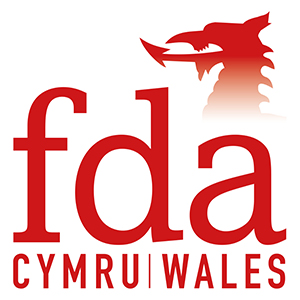Dydd Gwyl Dewi: St David’s Day and the importance of Welsh culture
FDA National Officer for Wales Gareth Hills reflects on what St David’s Day means to him, and the importance of preserving and celebrating Welsh culture and history.

As a child growing up in the Garw Valley – a ‘dead-end’ valley with one road in, the same road out – St David’s Day meant school concerts – eisteddfodau. We’d sing (mostly) Welsh language hymns, and recite (mostly) Welsh poems – and most of it we could barely understand.
The girls would dress up in traditional Welsh shawls and tall black hats and we’d all wear leeks or daffodils. The schools would close at noon for a half-day holiday. That would usually involve us walking home chomping on raw, soggy leeks!
Those childhood St David’s Day celebrations instilled in me an enduring pride and passion for Wales and Welsh culture, and having started as FDA National Officer for Wales on March 3rd 2020, the day now has extra significance for me as it marks the anniversary of my last day as a civil servant.
I have lived in Bristol for 23 years and, while I love the city where I met my wife and have a settled family home, I still get regular pangs of ‘hiraeth’* for my homeland.
It was while on a call with members at Estyn early in lockdown v.01 that I mentioned wanting to learn Welsh again, having last studied it for GCSE. As you’d expect from educational professionals, I was pointed in the direction of Dysgu Cymraeg/Learn Welsh. I checked out their online learning offers and eased my way in by watching daily 10-minute YouTube starter sessions. Since last summer, I’ve been working my way back to GCSE level using their manuals for Entry, Intermediate, and Higher stages.
I don’t claim that I’ll ever be fluent, but being able to introduce myself and make polite (if basic) conversation in Welsh has definitely proved an asset, particularly in meetings with the cultural institutions I cover – Amgueddfa Cymru (National Museum of Wales) and Lyfrgell Genedlaethol Cymru (National Library of Wales). Indeed, it is not unknown for meetings with the latter to be conducted entirely in Welsh with simultaneous English translation!
The National Library is based in an imposing building on Penglais Hill in Aberystwyth and has magnificent views of Cardigan Bay. The Library is home to over 6.5 million books and periodicals, and has the largest collections of archives, portraits, maps and photographic images in Wales, including some of the most important historical Welsh manuscripts, with the earliest dating back to 113 AD.
In my final year at University College of Wales, Aberystwyth, I was fortunate enough to obtain a National Library reader’s ticket, in the days when final year students had to be sponsored by a university tutor to apply. Fortunately, a note from the great, and sadly late, Professor PDG Thomas (a leading historian of the Georgian period) secured me a ticket, and the wealth of materials was invaluable to me when researching and writing my dissertation.
The National Museum of Wales now has seven sites across Wales, but the site I was most familiar with in my childhood, through many a school and family trip, was another imposing building in Cathays Park, Cardiff. Along with City Hall and the Crown Court (where I started my career as a civil servant) the Museum forms an impressive triple frontage to Cardiff’s civic centre.

That personal understanding and appreciation of the historical, and future, importance of the Library and Museum to the culture of Wales was something I drew on time and again when campaigning for increased and sustainable Welsh Government funding for the institutions. Our cultural institutions safeguard more than physical collections, they safeguard the nation’s collective historical culture.
Following months of lobbying Senedd members, I was delighted at Welsh Government’s announcement early in February of a two-year funding package of £6.5m to support the institutions, and said it felt like ‘a fresh start for culture in Wales’. That package has provided both institutions with much needed breathing space and has warded off proposed redundancies, protecting hundreds of jobs across the length and breadth of Wales, and we will continue to campaign to ensure these funding increases are sustained. This will be key to protecting Welsh heritage and Welsh jobs, and delivering a meaningful fresh start for Welsh culture.
I’ll celebrate St David’s Day this year in the knowledge that my childhood stirring of pride and passion for Wales and its culture has never wavered, in fact as FDA Wales National Officer I feel more Welsh than at any time since crossing the (original) Severn Bridge!
*‘Hiraeth’ is almost untranslatable into English. The best way to describe its meaning is an aching, nostalgic, longing for a time and place – usually home, and usually Wales itself.
Related News
-

Under significant pressure: Interview with Director of Public Prosecutions
Tom Nathan speaks to Crown Prosecution Service Director of Public Prosecutions Stephen Parkinson about CPS’s handling of riots, the importance of impartiality and his plan to help reduce unmanageable prosecutor caseloads.
-

Changing the culture
HM Chief Inspector Sir Martyn Oliver sat down for an ‘in conversation’ event with FDA General Secretary Dave Penman, discussing the pace of change in Ofsted, challenging perceptions and tackling the long hours culture in Education.
-

Hybrid working: Led by evidence, not headlines
Tom Nathan shares the findings and recommendations of the FDA’s recent report on ‘The future of office working in the civil service’.